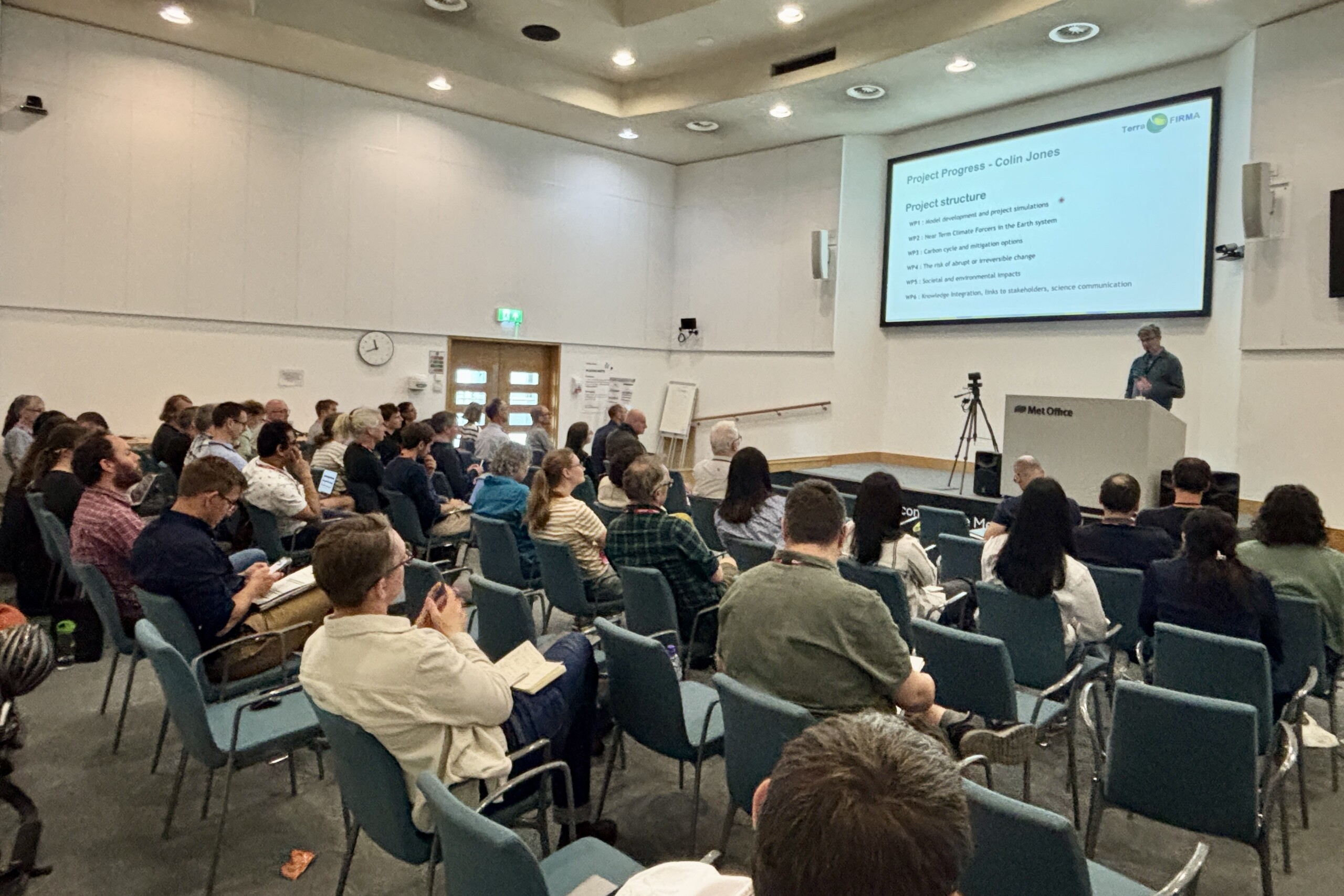News
20 years later: Tropical ecosystems in a world without fire
Douglas Kelley
UK Centre for Ecology and Hydrology
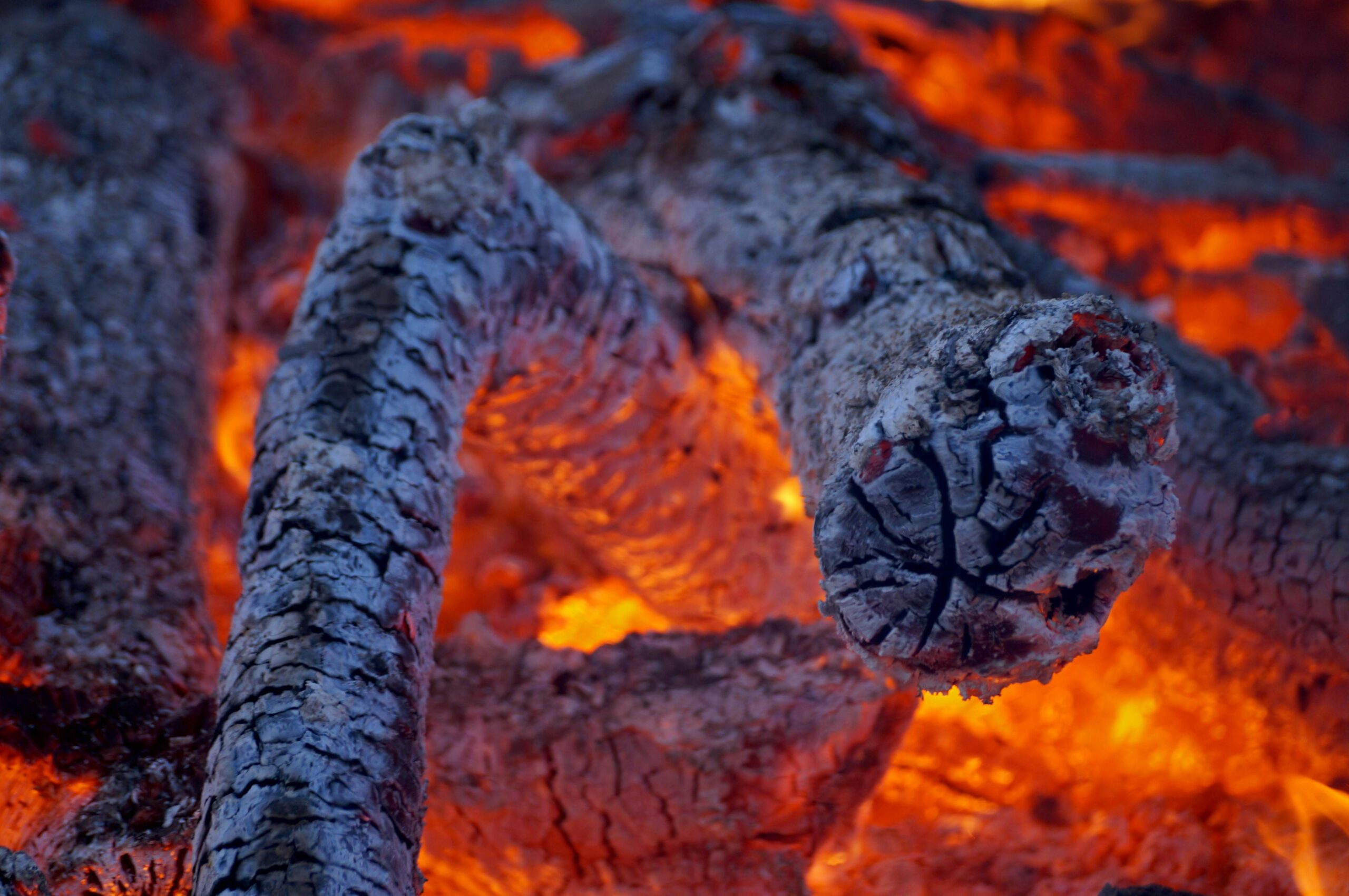
Over the past two decades, land surface and Earth system models have increasingly used fire to explain tropical ecosystem distributions, particularly the surprising scarcity of trees in savannas. However, our findings suggest a shift in perspective is needed: savannas are more fire-adapted than models assume. Instead, the role of fire in the future of forests needs attention.
Reimagining Fire’s Role in Tropical Ecosystems
For decades, the question of how fire shapes the boundaries of tropical ecosystems has been one of the most intriguing—and contested—in both ecology and terrestrial Earth system science. The debate gained prominence after Bond et al.’s land surface model simulations in the landmark 2004 study, “A World Without Fire”, suggested that fire could be preventing half of the world’s forests from existing. This provocative idea spurred two decades of model development, inspiring fire-enabled vegetation models to simulate how fire influences the global distribution of forests and savannas.
Yet, even as the modelling community raced to use fire to burn down their overly extensive virtual Earth system model forests, the ecological debate around fire’s true impact rages on. Is fire’s impact so deeply woven into local vegetation’s evolutionary history that it barely alters tree cover? Or does it trigger runaway feedback loops that lock savannas into fire-prone states, excluding forests entirely? To revisit these questions, our team leveraged modern tools and datasets that were unavailable for Bond et al. in 2004. In doing so, we’ve uncovered new insights into fire’s impact on tree cover—and how models like JULES and UKESM (the UK Earth System Model) might be burning down the wrong forests and need to evolve to better capture fire’s true and changing effects.
A World Without Fire: The Starting Point for Fire Modelling
The “World Without Fire” study suggested that fire is more than just a disturbance in savannas—it acts as a powerful feedback mechanism that shapes the global landscape. The idea is that fire suppresses tree growth, allowing grasses to thrive, which in turn fuel even more frequent fires, removing yet more trees. This self-reinforcing cycle seemed to explain why savannas and forests, despite often facing similar climate conditions, looked so different.
But as subsequent research dug deeper, the picture became more complicated. Satellite data, long-term “fire exclusion” experiments and ecological models reveal conflicting results. In some cases, fire seems to have little impact on tree cover, while in others, removing fire leads to a surprising increase in tree cover. The reason for these differences remained unclear until now, and this discrepancy has crucial implications for vegetation models like JULES and UKESM, which aim to predict how fire impacts ecosystems at both local and global scales.
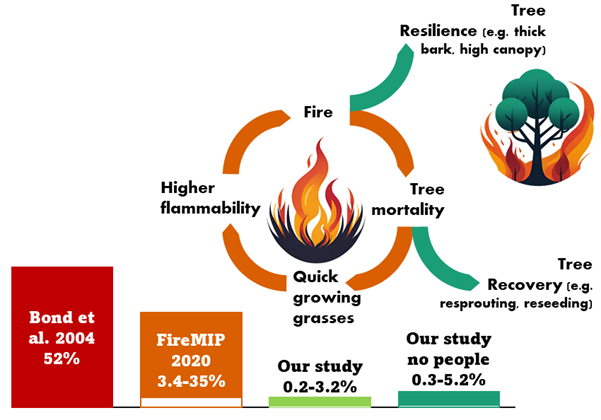
Figure 1: The impact cycle of fire on tropical tree cover. Bond et al. (2004) (red bar) explored a “world without fire” using a global dynamic vegetation model, much like JULES-ES with INFERNO, to estimate how much additional tree cover might exist without fire. Their globally aggregated results, inspired a generation of research on fire-vegetation dynamics. Lasslop et al. (2020) (orange bar) revisited this concept with seven newer global vegetation models from FireMIP, which include an early version of JULES with fire feedbacks. In our study, the light green bars show a comparable estimate of fire’s impact, while the dark green bars illustrate a higher potential effect if human influences—such as fire suppression and land use—are excluded, thereby maximizing fire’s theoretical role in limiting tree cover. The diagram also highlights the savanna-fire feedback hypothesis, depicting the loop where fire reduces tree cover, promoting flammable grasses, which in turn drive more fire. However, the green arrows suggest how ecosystems may evolve traits over time—like fire-resistant trees or rapid regrowth—that weaken or disrupt this feedback, altering its long-term impact. Reproduced from Does fire limit tropical tree cover?, on SpringerNature Research Communities
Revisiting Fire’s Impact with Modern Tools and Data
To refine our understanding, we employed advanced Bayesian statistical techniques, which allowed us to integrate uncertainty and capture the complex, non-linear interactions between fire, climate, human activity, and vegetation. Coupling these techniques with global satellite data—data that barely existed when Bond’s landmark study was published—provided a powerful framework for re-examining fire’s role.
What we found was surprising. Across tropical ecosystems, fire reduces tree cover, but its impact is much smaller than previously thought. On average, fire accounts for just 0.3–3.2% of “missing” tree cover across the tropics, rising to 0.3–5.2% when excluding human influences such as fire suppression and land use change. In drier savannas, these numbers are slightly higher, ranging from 0.6–7.1% (or up to 10.8% without human impacts).
These results challenge the assumptions built into most fire-vegetation models, including JULES. Simply put, the fire’s impact on tree cover is much less than these models suggest. And fixing the distribution of tropical tree cover shouldn’t be the primary motivation for incorporating fire feedback into UKESM.
Beyond Savannas: Fire’s Growing Threat to Forests
So does this mean fire is not important? Not at all.
But fire’s influence is not uniform. In savanna ecosystems, trees have evolved a suite of fire-adaptive traits, from thick bark, canopies above the flames, and rapid resprouting to fire-triggered seed germination. These adaptations help explain why fire’s impact on tree cover is often smaller than expected. But in tropical forests, where historically fires have been less common, and trees lack these traits, fire can cause significant tree loss—even with small increases in burnt area.
For example, we found that a 1% increase in burnt area in some forest regions, such as the eastern Amazon or Indonesia, could lead to a 2% decrease in tree cover, though granted with large uncertainty. These forests, already under pressure from climate change and human activity, could be highly vulnerable to fire-driven degradation, with projections showing that they will almost certainly see more fires in the future.
JULES and, by extension, UKESM must navigate this duality. For savannas, we need to better represent fire resilience and recovery. But for forests, capturing the sensitivity to fire is critical for projecting the cascading effects of increased fire activity on carbon storage and biodiversity.
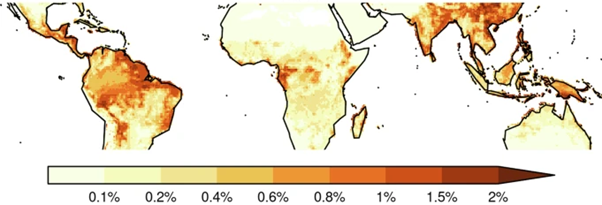
Figure 2: Areas of potential high sensitivity of tree cover to fire. This map highlights regions where tree cover is particularly sensitive to changes in fire activity, measured as the percentage change in tree cover per 1% increase in burnt area. Potential hotspots of sensitivity include Western African forests, the southern and eastern Amazon, Southeast Asian forests, and areas across Indonesia and Malaysia. These regions are identified as vulnerable to fire-driven tree cover loss. It’s important to note that these are potential hotspots, and the paper emphasizes high uncertainty in some of these areas due to the complex interactions between fire, climate, and vegetation. Reproduced from Does fire limit tropical tree cover?, on SpringerNature Research Communities
Bridging Model Insights and Real-World Observations
On the face of it, it seems like models like JULES should align with local fire exclusion studies. Both predict fire’s significant impact on tree cover, especially in savannas. However, our research complicates this picture. While local studies show that removing fire can lead to substantial increases in tree cover, our study reveals that, across the tropics, fire’s overall impact on tree cover is much smaller than many global models suggest.
So, why the disconnect? One key issue is how models like JULES distribute fire across vast areas. These models often treat fire as a blanket force, assuming it affects entire grid cells equally. In reality, fire is more localized, often repeatedly impacting certain areas, like grasslands, while leaving forests largely untouched. This oversimplification in model like JULES can lead to an overestimation of fire’s impact on tree cover on larger scales, even though, on smaller scales, fire’s impact can still be quite large.
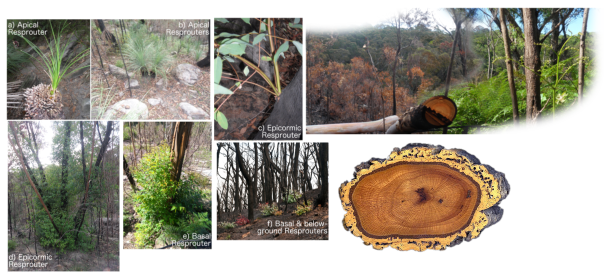
Figure 3: Fire resilience and recovery in action. These images showcase the remarkable ability of some tree species to recover after a fire. Top, right picture contrast 6 days vs 6 months after a September 2023 burn in Lane Cove National Park, NWS, Sydney. Bottom right shows the thick protective bark of a Quercus Suber, an Oak found in fire-y Mediterranean landscapes. Plant resprouting images show:
a) A Xanthorrhoea plant sprouting a single Apical shoot just six months after fire;
b) Xanthorrhoea resprouting in the understory after four months;
c) A Eucalyptus tree showing new growth from epicormic buds after four months;
d) Another Eucalyptus, now with multiple epicormic shoots eight months after fire;
e) Basal resprouting on a Eucalyptus trunk six months post-burning;
f) Widespread basal resprouting in a fire-affected Eucalyptus woodland four months post-fire.
Images were taken in fire-y regions of South East Australia, highlighting the adaptations that enable these ecosystems to endure and recover. Reproduced from Kelley PhD thesis, images taken by Douglas Kelley except f) basal resprouting, which is courtesy of Caueld, S.: Kinglake, Australia, June 2009 and Quercus Suber, by Plantsurfer
Reproduced from Does fire limit tropical tree cover?, on SpringerNature Research Communities
Another consideration is that our study, which looked at average conditions between 2000 and 2013, provides a snapshot rather than a dynamic view of how fire shapes ecosystems. Other factors, such as deforestation or drought, often interact with fire in complex ways, and our study doesn’t account for all of these temporal shifts. This means our results and the model experiments might not be measuring exactly the same thing, presenting interesting avenues to extract fire’s changing effects from observations in order to inform our model development fully. However, this is unlikely to be the root cause of the orders of magnitude difference between estimates.
Why Fire Modelling Matters for Carbon Dynamics
Accurately modelling fire impacts is critical for understanding global carbon dynamics. Tropical forests and savannas are pivotal carbon sinks, and fire’s role in shaping these ecosystems has significant implications for carbon storage.
Our findings suggest that fire-vegetation models like JULES may overestimate fire’s impact on carbon stores in savannas, where fire and vegetation are often in equilibrium. In these systems, factors like rainfall variability or soil properties may be more important drivers of tree cover suppression. But in tropical forests, even small increases in fire frequency or intensity can lead to substantial carbon release, highlighting the need for models that can differentiate these dynamics.
Refining Models to Capture Fire’s Complexity
As we integrate fire into UKESM2, our findings highlight the need to improve how we represent fire’s interaction with vegetation. To project how emerging fire regimes will reshape ecosystems, we must build models that better capture the complex and heterogeneous nature of fire impacts.
Rather than focusing primarily on fire’s reduction of tree cover in savannas, we need to address its evolving role in the world’s forests. Achieving this is no small feat. Our recent offline analysis with JULES has begun shifting the focus to fire’s changing effects rather than its absolute impacts—a perspective that aligns more closely with the model’s strengths and limitations. However, with the demands of CMIP simulations, these nuanced approaches won’t always be feasible. Tackling these challenges directly is essential.
Several promising avenues stand out:
1. Fire-adaptive traits: Savanna trees often exhibit adaptations such as thick bark, resprouting, and changes in canopy structure. Incorporating these traits into models can help simulate the resilience and recovery observed in real-world ecosystems. Related concepts already exist in JULES and are gradually making their way into UKESM2. For instance, thermal acclimation—used to model plants’ changing responses to heat stress—could inform the inclusion of fire-adaptation mechanisms. Similarly, JULES’s “SUGAR” module, currently simulating non-structural carbohydrate (NSC) reserves for drought resilience, could be extended to represent how plants allocate energy for post-fire recovery, including resprouting and fire-triggered seed germination.
2. Canopy structures and ecosystem demography: The RED (Robust Ecosystem Demography) module in JULES offers a pathway to simulate how vegetation regrows and reorganises after fire. It can help model how tree canopies escape the flames, providing a more detailed view of post-fire dynamics.
3. Sub-grid heterogeneity: Representing the patchy and localised nature of fire within model grid cells could reduce over estimations of fire’s influence on tree cover and carbon storage. This approach would reflect the reality of fire’s uneven impacts on landscapes, improving model fidelity.
By pursuing these refinements, we can move from static assumptions to dynamic representations of fire-vegetation interactions, capturing both the immediate effects of fire and the long-term recovery processes that shape ecosystems.
Ultimately, this work goes beyond improving specific models. It aims to deepen our understanding of fire’s role in ecosystems and to inform strategies that protect tropical forests, sustain carbon sinks, and enhance resilience to climate change. As fire extremes increase in the world’s tropical forests—from the Amazon to Australia—such insights will be critical for mitigating future risks and fostering a sustainable future in our increasingly fire-y forests.
This summary is based on a recent blog post, Does fire limit tropical tree cover?, discussing the new study “Fire, environmental and anthropogenic controls on pantropical tree cover” by Douglas I. Kelley, France Gerard, Ning Dong, Chantelle Burton, Arthur Argles, Guangqi Li, Rhys Whitley, Toby R. Marthews, Eddy Roberston, Graham P. Weedon, Gitta Lasslop, Richard J. Ellis, Ioannis Bistinas & Elmar Veenendaal.
https://doi.org/10.1038/s43247-024-01869-8

